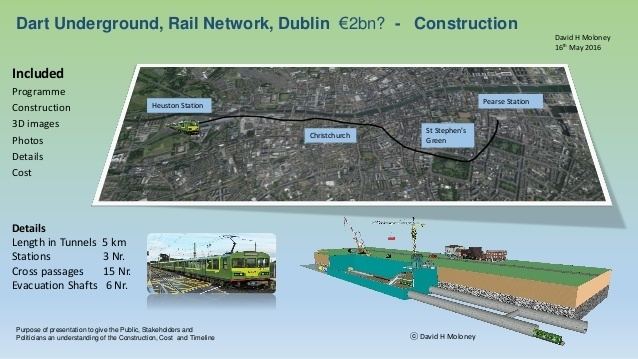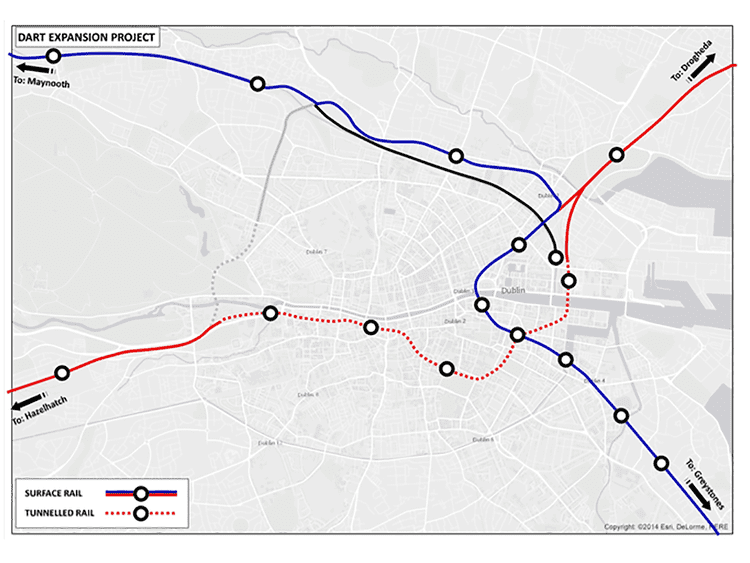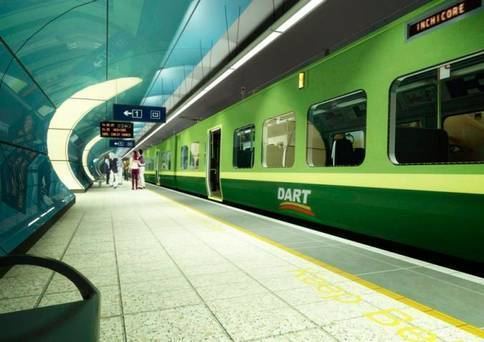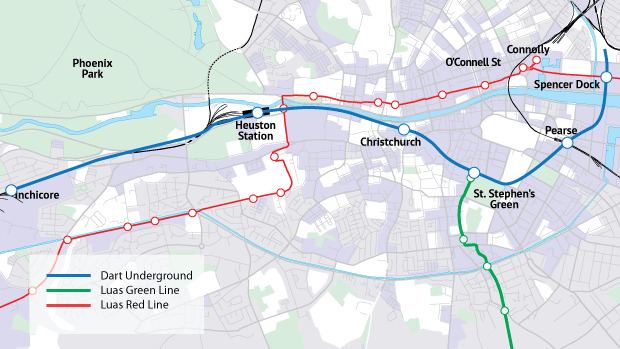System DART Termini DocklandsInchicore | Stations 6 | |
 | ||
Status Being redesigned (as of 2015) | ||
Dart underground
DART Underground (Irish: DART Faoi Thalamh), previously known as the Interconnector, is a planned railway tunnel in Ireland, projected to run under the city centre of Dublin. The planned tunnel is intended to allow for the expansion of the electrified DART and the Dublin Suburban Rail network, and to connect Heuston Station with Pearse Station. In November 2011, the government announced that the project would be deferred until 2016 at the earliest. On 22 September 2015, it was announced that the project was to be redrafted to a lower cost design. And, in October 2016, a "scaled down" plan was published with a target commencement date (subject to railway orders and planning permission) "in 2020".
Contents
- Dart underground
- Dart underground could be back on the agenda
- History
- Specifics
- Status
- Opposition
- References
The original DART Underground plans proposed an underground link between the existing Northeast DART line between Malahide/Howth and Clontarf Road and the Western Rail line between Heuston and Hazelhatch, with new underground stations across Dublin's city centre at the Docklands, Pearse Station, St. Stephen's Green, Christchurch, and beneath Heuston Station. Despite this not being a very direct route, the decision by An Bord Pleanála specifically referred to a national policy requirement that the line be built through St. Stephen's Green. The project also expected the construction of a new overground station at Inchicore.

Dart underground could be back on the agenda
History

DART Underground was first proposed in 1972 in the "Transportation in Dublin" study conducted by An Foras Forbartha, an anteceding body to Forfás (sometimes erroneously referred to as the 'Dublin Transportation Study') as an underground rail link to connect the 3 main Dublin Railway Stations.

In 1975 CIÉ commissioned the Dublin Rapid Rail Transportation Study and which recommended a 4 Phase plan including a prototypical Dart Underground.
Phase 1 Upgrade and electrify Howth – Bray (completed 1984 as the DART).

Phase 2 An Underground line from Connolly to Heuston. Rapid Transit tracks Heuston to Clondalkin overground. Spur to Tallaght from Clondalkin (a small part was completed in 2010 when Rapid Transit tracks were installed either side of Clondalkin)

Phase 3 A short northerly spur off the Maynooth line to Blanchardstown and a short southerly spur to Broadstone. (The former was never completed but was partly revived in 2001 as Metro West before that was itself shelved in 2011 and the latter spur will be completed as Luas Cross City in 2018.)
Phase 4 An underground tunnel from Broadstone to Sandymount. (This was later redesigned as Metro North from Drumcondra to St Stephen's Green and shelved indefinitely in 2011.)
The DRRTS, if completed as envisaged in 1975, would have resulted in a cross shaped pair of tunnels in the city centre meeting at a central station in Temple Bar.
The plan was next proposed in 2001 as an 'Interconnector' in the Platform For Change strategy report issued by the now defunct Dublin Transportation Office or DTO.
A Railway Order permitting the construction of the project was granted in December 2011 by An Bord Pleanála. In August 2014, Minister for Transport Paschal Donohoe TD was told that both the Dart Underground and Metro North projects would have had to rely on private funding if they were to be built. In 2010, the estimated projected cost for DART Underground was €4 billion, more than half of which was expected to be provided by a public private partnership arrangement. Mr Donohoe was told he had to decide on whether to proceed with DART Underground by 24 September 2015 when the Railway Order giving authority and planning approval expires. A High Court ruling reduced the period for which compulsory purchase order notices could be issued from seven years to 18 months. The NTA's Greater Dublin Area draft Transport Strategy 2016 – 2035 published in October 2015, expressed the desire to see the tunnel completed as part of the over all DART extension programme.
Specifics
Dublin's existing DART line runs in a north-south along the Eastern seaboard from Malahide and Howth to the North of the city to Bray and Greystones to the south of the city in County Wicklow. The line passes through the city centre by means of the elevated Loopline Bridge across the River Liffey between Connolly and Pearse stations passing the elevated Tara Street Station on the South bank of the river Liffey.
If DART Underground was completed, the present single-line DART would be replaced by two DART lines forming a rough X and intersecting at Pearse Station. The first line would begin in to the north-east of the city in Howth/Malahide following the existing DART line to Clontarf Road but then diverging eastward into a tunnel and to a new underground station in the Docklands and then westward to a new underground station near Pearse Station, under St Stephen's Green (where it would interconnect with the proposed Metro North), Christchurch, and directly beneath Heuston Station. Emerging from the tunnel the line would then continue to a new overground station at Inchicore after which it would follow the existing South Western Commuter line to Hazelhatch to the west of the city.
A second DART line would follow the existing southern DART line from Bray/Greystones to Connolly Station, from which it would diverge on the existing but un-electrified line from Connolly to Maynooth to the northwest of the city in County Kildare with a branch off the line at Clonsilla to M3 Parkway, County Meath.
Status
In May 2010, Iarnród Éireann anticipated that if construction had begun in 2012 the tunnel would have been operational by 2018.
On 30 June 2010, Iarnród Éireann submitted an application to An Bord Pleanála for a Railway Order for the scheme under the Transport (Railway Infrastructure) Act 2001. Under this Act, the Board charged with considering planning, environmental and property issues regarding proposed developments.
The November 2011, the government deferred funding the project due to the decrease in capital spending until 2016 at the earliest.
A month later, in December 2011, in the Railway Order was granted for the development. The granting of the Railway Order permitted both the construction of the scheme and any necessary compulsory acquisition of property. It did not however commit funding to the project.
According to Iarnród Éireann, the government had indicated that funding the project would be reconsidered in the next capital investment programme. Because this will not take place before 2016, the tunnel would not have been completed by 2018 even if funding was approved in that next budgetary cycle.
On 22 September 2015, it was announced that the project had been cancelled in favour of a simpler alternative. However it may return as part of a future DART Expansion Programme, starting no earlier than 2020 or 2021.
Opposition
There was considerable opposition to the project in Dublin's East Wall area where the tunnel would have begun and where tunnelling operations were planned to be located. People also complained that while they would have had to endure the disturbance created by the tunnelling works, they would not gain anything from the project as they would not have easy access to a DART station since they were roughly halfway between the existing Clontarf Road station and the proposed Docklands station. Iarnród Éireann responded, claiming that they can use Clontarf Road Station. It is a roughly 20 minute walk from East Wall to Clontarf Road station.
